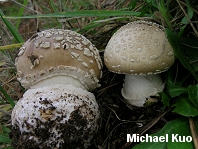| Major Groups > Gilled Mushrooms > Pale-Spored > Amanita > Amanita pantherina |

|
Amanita pantherina [ Basidiomycetes > Agaricales > Amanitaceae > Amanita . . . ] by Michael Kuo As with so many North American species of Amanita, the West-Coast mushroom described and illustrated here is probably an unnamed species (or group of species) currently passing as a European species. Like the European Amanita pantherina, North American versions have brown caps that are covered with white warts, as well as a collar-like roll of veil tissue at the top of the stem's basal bulb, and ellipsoid, inamyloid spores. The western North American version is associated primarily with conifers, and has a variable cap that ranges from dark brown to pale tan or nearly yellowish (creating confusion with Amanita gemmata). Amanita expert Rod Tulloss has provided preliminary documentation for a putative species he has provisionally named (2013); it may correspond to the mushroom described here. Another contender, at least for pale forms with less conspicuous rolls of volval remnants on the bulb, is the legitimately named Amanita pantherinoides, first described from the Pacific Northwest by Murrill in 1912, and later reduced to varietal status as Amanita pantherina var. pantherinoides by Jenkins (1979). Description: Ecology: Mycorrhizal with conifers--especially pines like bishop pine and Monterey pine, but also with Douglas-fir, spruces, and (occasionally) with hardwoods; growing alone, scattered, or gregariously; fall and winter; along the West Coast from California to the Pacific Northwest, and reported from the southwestern Rocky Mountains. Cap: 3-18 cm, convex, becoming broadly convex or flat; sticky when fresh; brown to tan or yellowish brown; bald; adorned with numerous cottony, whitish warts; the margin sometimes somewhat lined at maturity. Gills: Free from the stem or nearly so; white; crowded; short-gills frequent. Stem: 4-20 cm long; up to 2.5 cm thick; tapering to apex and ending in a swollen basal bulb; somewhat scaly or fairly bald; whitish; with a skirtlike, whitish ring above, and a roll of tissue from the universal veil forming the upper margin of the bulb--or, occasionally, with concentric rings of volval material. Flesh: White; not discoloring on exposure, or turning slightly yellowish in the stem. Spore Print: White. Microscopic Features: Spores 8-14 x 6-10 µ; smooth; ellipsoid; inamyloid. Basidia 4-spored; rarely with clamps. Pileipellis an ixocutis of hyphae 2-7 µ wide. Lamellar trama bilateral; subhymenium ramose. REFERENCES: (de Candolle, 1815) Krombholtz, 1836. (Fries, 1821; Saccardo, 1887; Smith, 1975; Smith, Smith & Weber, 1979; Thiers, 1982; Arora, 1986; Jenkins, 1986; States, 1990; Phillips, 1991/2005; Lincoff, 1992; Roody, 2003; Miller & Miller, 2006; Trudell & Ammirati, 2009.) Herb. Kuo 01170504. This site contains no information about the edibility or toxicity of mushrooms. |
© MushroomExpert.Com |
|
Cite this page as: Kuo, M. (2013, April). Amanita pantherina. Retrieved from the MushroomExpert.Com Web site: http://www.mushroomexpert.com/amanita_pantherina.html |
